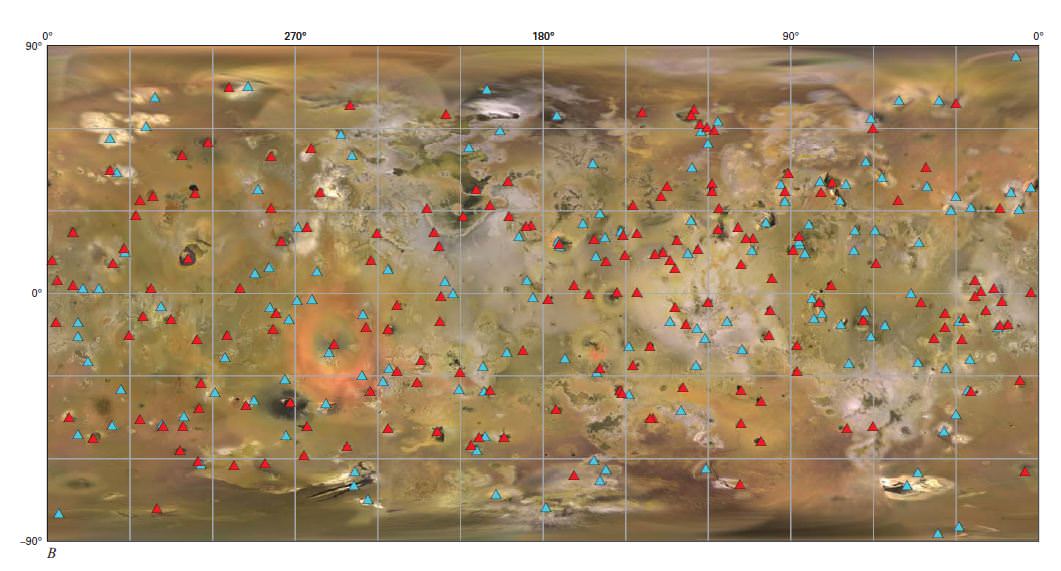[/caption]
With billowing volcanoes, lava lakes and a sulfurous landscape, Jupiter’s moon Io is one of the most exotic and intriguing places in the Solar System. The geologic features of Io are now detailed in the first global geologic map ever made of this unusual and active planetary body. The map, published by the U. S. Geological Survey and created by scientists from the Planetary Science Institute and Arizona State University, shows the characteristics and relative ages of some of the most geologically unique and active volcanoes and lava flows ever documented in the Solar System.
Want to figure out where you’d like to go mountain climbing or conduct a little volcanology on Io?
“One of the reasons for making this map was to create a tool for continuing scientific studies of Io, and a tool for target planning of Io observations on future missions to the Jupiter system,” said David Williams, who led the six-year research project to produce the geologic map.
On this detailed map there are 19 different surface material types. You can see all sorts of volcanic features including: paterae (caldera-like depressions), lava flow fields, tholi (volcanic domes), and plume deposits, in various shapes, sizes and colors, as well as high mountains and large expanses of sulfur- and sulfur dioxide-rich plains. The mapping identified 425 paterae, or individual volcanic centers.
“Our mapping has determined that most of the active hot spots occur in paterae, which cover less than 3 percent of Io’s surface. Lava flow fields cover approximately 28 percent of the surface, but contain only 31 percent of hot spots,” said Williams. “Understanding the geographical distribution of these features and hot spots, as identified through this map, are enabling better models of Io’s interior processes to be developed.”
However, there is one feature you won’t see on the geologic map: impact craters.
“Io has no impact craters; it is the only object in the Solar System where we have not seen any impact craters, testifying to Io’s very active volcanic resurfacing,” says Williams.
Although Io is so volcanically active — more than 25 times more volcanically active than Earth — most of the long-term surface changes resulting from volcanism are restricted to less than 15 percent of the surface, mostly in the form of changes in lava flow fields or within paterae.
Interestingly, the new map comes from fairly old – but enhanced – data. It combines the best images from the Voyager 1 and 2 missions (acquired in 1979) as well as the Galileo orbiter (1995-2003), and is unique from other USGS-published planetary geologic maps because surface features were mapped and characterized from using four distinct global image mosaics.
“Because of the non-uniform coverage of Io by multiple Voyager and Galileo flybys, including a variety of lighting conditions, it was absolutely necessary to use the different mosaics to identify specific geologic features, such as separating mountains and paterae from plains, and separating the colored plume deposits from the underlying geologic units,” Williams said.
Though the geology history of Io has been studied in detail for several decades, completion of the geologic map establishes a critical framework for integrating and comparing diverse studies.
Because of Io’s active nature, this map may not be completely accurate to Io’s current appearance. “Because Io is so active, and continues to be studied by Earth-based telescopes, we are doing something different than producing just the paper geologic map,” says Williams. “We are also making an online Io database, to include the geologic map, the USGS mosaics, and all useful Galileo spacecraft observations of Io. This database, when completed later this year, will allow users to track the history of surface changes due to volcanic activity. We also have proposals submitted to NASA to include in our Io database Earth-based telescopic observations and images from the February 2007 NASA New Horizons spacecraft flyby, to create a single online source to study the history of Io volcanism.”
The geologic map can be downloaded from the USGS here.
Source: ASU

